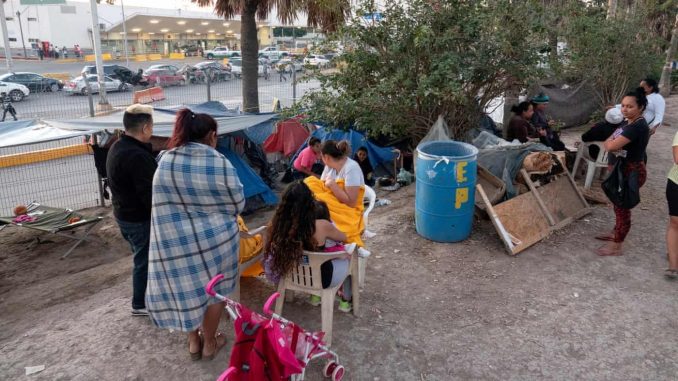
Esmeralda Martínez got the news via a WhatsApp message: a court had invalidated the US “remain in Mexico” program, which had obliged her to stay put south of the border while her asylum claim was heard.
It had been six months since she fled Guatemala after the murder of her husband. For a brief moment, it seemed she and her 13-year-old daughter Jazmín might be able to move on from the dismal frontier encampment were they have been stranded.
She packed her court papers in a black and yellow backpack, stuffed her clothes into a suitcase and prepared to move on.
But just hours after Friday’s ruling, the same three-judge panel suspended its own order pending fresh arguments, leaving the policy formally known as Migrant Protection Protocols (MPP) in full effect.
Despite the confusion, the temporary invalidation of MPP offered rare hope for around 2,500 migrants living in the insecure and insalubrious tent city along the Rio Grande in the city of Matamoros, a stronghold of the notorious Gulf Cartel.
Dozens of asylum-seekers, some clutching printed copies of the 57-page court decision, headed straight to the bridge separating Matamoros and Brownsville, Texas. They were turned back by US border guards.
“We were all hoping for this inhumane and macabre program to be invalidated,” said Joel Fernández, 51, a Cuban asylum-seeker who also had his bags packed.
MPP has forced more than 60,000 migrants to wait in some of Mexico’s most dangerous cities. The Mexican government pledged to provide work permits and access to healthcare, housing and educational opportunities, but those promises have largely gone unfulfilled.
And as they wait, the migrants are easy targets for criminal gangs.
In one month last year, three-quarters of asylum seekers seen by physicians working for Doctors Without Borders in the city of Nuevo Laredo reported having been kidnapped for ransom.
“It’s tough living here,” said Martínez, 30, as a pot of beans boiled over an open fire outside her tent. “It’s cold. It’s unsafe. We’ve been followed three times [by the gangs]”.
Over the weekend, immigration lawyers attempted to clear the confusion, convening scrums of migrants and trying to answer their questions.
“There’s good news and bad news,” said Jodi Goodwin, a Brownsville immigration attorney, counselling the asylum seekers stay the course: “Everyone must continue preparing their cases; you need to continue going to court.”
She also cautioned against illegal entry to the US.
“The risks if you jump the river are one these consequences: you go to prison or you go to Guatemala [where the US is now sending asylum seekers] or you’ll face expedited expulsion,” she said.
The number of asylum claims in cities like Brownsville has been declining. A crackdown by Mexican authorities has choked the migrant flow, while expedited expulsion and the new policy of sending migrants to Guatemala has reduced the numbers of people waiting for an asylum decision.

“We’re seeing dramatically lower numbers in Brownsville,” said Charlene D’Cruz, an immigration lawyer.
MPP “worked” as proponents hoped, D’Cruz said, as “it took 60,000 people out” of the traditional asylum process. “But do we mean by success? Humanity-wise, we have completely failed as a people.”
As the number of asylum seekers from Central America and further afield slowly dwindles in Matamoros, a new group has replaced them: Mexicans fleeing rampant violence in central and southern states.
Mariana came to the camp with her family six weeks ago from Veracruz state, where she says a drug cartel tried to forcibly recruit her teenage son.
Her turn to apply for asylum was fast approaching – and couldn’t come fast enough.
“We’ve gone hungry. We’ve been cold. We’ve had to bathe in the river,” she said as she cooked eggs and chilies for her children. “This is a desperate place.”
*Story by The Guardian